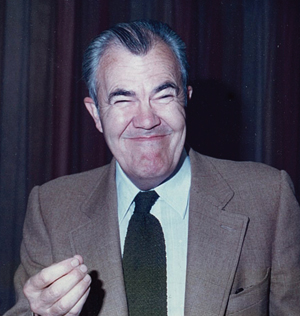Fall 2014 (Volume 24, Number 3)
Harold Robinson
By Andrew Chalmers, MD, FRCPC
Download PDF

1919 - 2014
When Harold Robinson passed away on April 13th, 2014,
the Canadian rheumatology community lost an icon.
Harold graduated in Medicine from McGill and then joined the Canadian Army Medical Corps. After the war he spent time doing medical training in rheumatology in London, England. He then returned to Banff to work with his father and brother as a family physician and, with his father, treated patients with rheumatoid arthritis (RA) with gold. He moved to Vancouver in 1951 to complete his studies in internal medicine. He became Medical Director of the Canadian Arthritis and Rheumatism Society (CARS), now The Arthritis Society (TAS), in Vancouver in 1956.
There was already an experimental program for arthritis rehabilitation: three traveling physiotherapists (PT) who visited patients in their homes. Harold championed the team approach to patient care through medications, PT, occupational therapy (OT), and social work. He initiated a gold treatment program. Harold worked at a time when there were few medication options, but lived through a time when many became available.
Over 35 years he oversaw the growth of the BC Division, developing a network of physicians and OT outreach across British Columbia. This program served 24 BC communities and aboriginal reserves. The size of the program grew with centres in Vancouver, Victoria, Penticton, and Cranbook as well as in-patient beds at the GF Strong Hospital in Vancouver.
His interest and expertise became internationally known; Harold was invited to speak and write about the team approach across the world. The Vancouver program resulted in a visit from members of the U.S. congress which drew forth this comment from Harold, “My view is the performance of the rehabilitation unit operated by CARS in Vancouver is not surpassed anywhere in the world”. He advocated for the development of a school of rehabilitation science at the University of British Columbia (UBC) because of a shortage of OTs and PTs.
Harold’s interests were broad and he authored 42 peer-reviewed papers, many on arthritis and spondylitis in Aboriginal patients, as well as other non-rehabilitation topics. He wrote chapters, published handbooks on RA rehabilitation, and spoke at many international meetings.
When I first met him as a Fellow in 1976 I was overawed by his presence but soon got to know him as a kind, considerate, thoughtful man. He was always posing questions; one I will never forget was, “Why when RA affects the right first metacarpophalangeal joint does it affect the left? Explain the symmetry and there is a Nobel Prize”.
At Christmas every year the staff of the Arthritis Centre put on a concert and every department presented their own piece. The doctors were invited to the Robinsons (Harold was a talented pianist and organist and his wife, Jean, a singer) to practice their program and all its shenanigans with piano accompaniment.
Harold was highly committed as a physician, educator, program director, collaborator, and scholar, quiet and unassuming.
He was recognized by his country with The Order of Canada and the Queen’s Silver, Gold, and Diamond Jubilee Medals, and by his colleagues as a Master of the American College of Rheumatology (ACR). At UBC, Harold was made Professor Emeritus at and had a Chair developed, The Harold Robinson Chair in Rehabilitation Science.
Andrew Chalmers, MD, FRCPC
Professor of Medicine and Rheumatology,
University of British Columbia (UBC)
Vancouver, British Columbia
|



